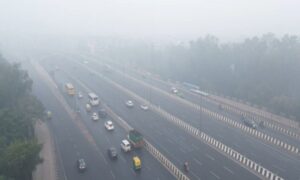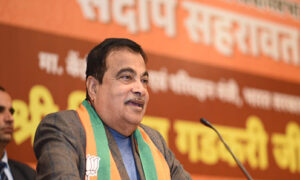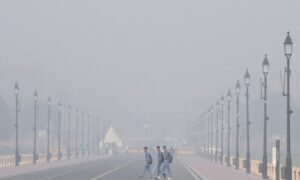
Photo: Hawkers, e-ricks outside a metro station (Self-clicked)
Delhi is the national capital of India and lies in the north of the country. Ever since the independence of India in 1947, a boom in economic growth, rapid industrialisation, and other job opportunities attracted people to Delhi from proximate areas. In 1991, the population of Delhi reached the staggering figure of 9.42 million and presently stands at about 18 million in an area of 1,483 sq. km with a population density of 25,535 sq. km. [v]
Different Modes of Transport
Underground and elevated infrastructure. The Metro has become one of the most crucial modes of public transport in Delhi since its commission in 2002. The Delhi Metro Rail Corporation (DMRC) is responsible for the planning, maintenance and operations of the Delhi metro network. The metro spans a network of about 213km with 160 stations. On an average, 2.6 million commuters travel by metro daily [iii]. During January 2016, on same days when the Odd-Even scheme (a 15 day pilot of keeping cars off the road based on their last digit on number plate) was in effect, the ridership also crossed the 3 million mark.
Connectivity across state jurisdictions has also been facilitated by the metro. Metro access to neighbouring cities of Gurgaon and Faridabad (in the state of Haryana), and Ghaziabad and Noida (in the state of Uttar Pradesh) has reduced travel time for many of those who live in these neighbouring cities but work in Delhi or vice-versa. Inter-modality has also improved with the metro as metro stations are located within walking distance of many important city nodes like the inter-state bus transport depots, railway stations and even the airport. Affordability (fare ranges from the USD 0.12 – 0.45) and predictability of a trip by metro add to its attractiveness.
Surface infrastructure. The city of Delhi has one of the largest road networks in India [viii]. The road network already occupies 21% of the total city area, limiting the potential for the future increase [i]; [ii]. Nonetheless, the modal share of Delhi is much better than any developed country as only 25% of the population is using private vehicles while the rest are using public or non-motorized transport (NMT) (see figure 1).

Modal share of Delhi as of 2014 (Source: Report of High Powered Committee on How to Decongest Delhi. 2014)
Nonetheless, the priority given to the construction of new road and flyover infrastructure to ease traffic congestion has spurred the growth of private vehicles. Adding to this is the middle-class aspiration of owning a car. However, the level of ownership of vehicles is still low when compared with developed countries – for instance, Delhi has 85 vehicles per 1000 persons whereas, in the UK, it is 760 vehicles per 1000 persons. [viii]
In this setting, the attractiveness of buses has fallen over the years, as is also shown in figure 2. The future looks bleak as a Bus Rapid Transit System (BRTS) commissioned in 2008 was taken down this year due to massive protest from the neighbouring areas. Thus, it is critical to identify areas for dedicated bus corridors and make bus services more reliable, convenient, attractive and efficient by reforming the bus system. Bus route rationalisation, use of IT can help fulfil this purpose to a great extent.

Source: Tiwari, 2011
The bus service faces multiple challenges:
- Competition among different bus operators: DMRC feeder buses and Delhi government buses are often seen competing for passengers on overlapping routes. They indulge in rash driving and sometimes skip bus stops as well, causing inconvenience to the passengers.
- No coordinating authority: The transport system in the city is highly fragmented. The presence of multiple bus operators, including many contractors, which are only concerned about their own routes and profitability has led to underservicing of lower-income group areas.
- Increasing model competition: Fall in the attractiveness of the bus service due to its poor quality, slow speed and poor last-mile connectivity has led to some of the affluent passengers to transition to the metro even for short trips [vii]. The modal share of the bus has fallen from 59.8% in 2001 to 41.5% in 2008 whereas the share of metro stood at 4.1% in 2008 (Figure 2). A further fall needs to be averted such that people transition from their private vehicles to the metro and not from buses to metro.
- Opposition to BRTS: The 5.8km dedicated BRTS, from the very beginning, faced a lot of opposition from the car lobby as it was seen as taking away their road space. The corridor was carrying more people per hour than all the vehicles put together but the efficiency of this network was not considered before deciding to scrap it. That a social challenge, coming from those upper-middle-income groups living adjacent to the corridor, could lead to the scrapping of the entire project must not have been anticipated during the initial stages of the project. [vi];[vii]. This submission of the government to the private vehicle lobby without attempting to discuss the benefits of a BRTS have clouded the future of any other BRTS network. This will prove to be highly detrimental to the public transport system in Delhi.
Other challenges and opportunities
Urban sprawl and mobility needs. The extension of NCT of Delhi into the National Capital Region (NCR) displays the sprawl tendencies of urban growth in Delhi. Sprawled over 34,000 sq. km area, NCR is the country’s largest planning region with a population of 46 million. As can be seen from figure 3, Delhi has expanded geographically to a large extent.

Spatial growth of Delhi (1950 – 2014)
Source: Nair, 2015
Delhi is faced with rising challenge of traffic congestion. The number of private vehicles (both two-wheelers and cars) is continuously rising in the city. As of 31 March 2015, Delhi had 8.83 million vehicles, up from 0.56 million in 1981, and this is only expected to rise. Frequent traffic jams across Delhi due to increase in number of personal vehicles further reduce the attractiveness of buses as the time taken by them increases due to absence to dedicated bus corridors. This, in turn, makes people shift to private modes of transport, further adding to congestion.
The influx of Intermediary Public Transport (IPT) like auto rickshaws, e-ricks, cycle rickshaws has added to the congestion on the roads as some of them are non-registered and flout a lot of traffic and parking norms.
Poor infrastructure for pedestrians and cycling is a major challenge that needs to be addressed to aid 35% of commuters walking to their destinations and 4% of those cycling in the city. Unsafe and inadequate cycling-friendly infrastructure has led to many short trips being made on private vehicles [vii]. To keep the modal share favourable to NMT, it is crucial to invest in dedicated cycling lanes and pedestrian pathways.
Environmental challenge. Last year, Delhi received the title of the ‘world’s most polluted city’. Although the burning of agricultural waste in the neighbouring state of Punjab played a big role, the increasing number of diesel vehicles on the streets were also to be blamed. This is not the first time that Delhi’s pollution hit an all-time high. In the late 1990s and early 2000s, industrial emissions and effluents from vehicles often left Delhi skies clouded with smog. So in 2002, a benchmark decision was taken to shift the entire public road transport system on CNG Fuel System. Now all auto-rickshaws, buses and even some cars are run on CNG. This had a tangible effect on Delhi’s air pollution level. [iv]
However, the ever-increasing number of diesel vehicles due to subsidies on diesel has again led to high levels of air pollution in recent times. Both particulate matter (PM10 and PM2.5), as well as nitrogen oxides, are increasing steadily. In fact, PM2.5 levels are normally 3 to 4 times the standards during winter times and are as high as 7 to 8 times the standards during smog. Ozone levels have also been rising. This has serious consequences for public health. [vii]
Information and Communication Technology. Integration of IT solutions with public transport system is missing across the city. The BRTS had limited success with LCD screens that displayed time for the next bus. An attempt was also made to link the bus system and the metro with a single smart card, but it hasn’t been operationalised. Much can be done with CCTV cameras installed on some of the streets and if their coverage is expanded, a robust control room can help in streamlining the transportation system of Delhi.
Conclusion
Delhi is the fourth largest city in the world and the ownership of private vehicles is rising in the city. A sustainable transport system requires that the Delhi government plans for an integrated public transport system and does not shy away from a fight with the private vehicle lobby. The higher modal share of NMT gives hope that a transition to public transport is possible if the services are made easily accessible, comfortable, efficient and attractive. Efforts to improve inter-modality are needed and use of IT solutions can help achieve these to a great extent.
References
[i]Advani, Mukti and Tiwari, Geetam. 2005. Evaluation of Public Transport Systems: Case Study of Delhi Metro. Available at http://tripp.iitd.ernet.in/publications/paper/planning/mukti_metro_kharagpur_05.pdf
[ii]Delhi Development Authority. No date. Master Plan of Delhi 2021, Chapter 12: Transportation. Available at https://www.dda.org.in/planning/docs/12_Transportation.pdf
[iii]Delhi Metro Rail Corporation. Press releases. Available at http://www.delhimetrorail.com/press_reldetails.aspx?id=D56csDWRltIlld
[iv]Government of NCT of Delhi. No date. Chapter 2: Transport. Available at http://delhi.gov.in/wps/wcm/connect/6f2ff080486859d58728c7e83e6e4488/Chapter2.pdf?MOD=AJPERES&lmod=-336296642&CACHEID=6f2ff080486859d58728c7e83e6e4488
[v]Kundu, Amitabh. 2011. Trends and processes of urbanisation in India. IIED & UNFA, Urbanisation and Emerging Population Issues – 6. Available at http://pubs.iied.org/10597IIED.html
[vi]Mohan, Dinesh. 2015. Powerful Lobbies want Delhi’s BRT scrapped. Here’s why they should not succeed. The Wire. Available at http://thewire.in/8396/powerful-lobbies-want-delhis-brt-scrapped-heres-why-they-should-not-succeed/
[vii]Report of High Powered Committee on How to Decongest Delhi. 2014. Available on http://www.indiaenvironmentportal.org.in/files/file/Report%20on%20How%20to%20Decongest%20Delhi.pdf
[viii]Sahai, Sanjiv N. and Bishop, Simon. 2009. Bus System Reform in Delhi. Delhi Integrated Multi-Modal Transit System Ltd. Available at http://www.dimts.in/pdf/bus_system_reform_in_delhi.pdf
This piece is the original writing of the author(s). The view points in the post are the author’s personal opinions and do not reflect IGLUS/EPFL’s viewpoints. The author(s) is the sole responsible person regarding the accuracy of the information presented in the post and will be liable for any potential copyright infringements.



















